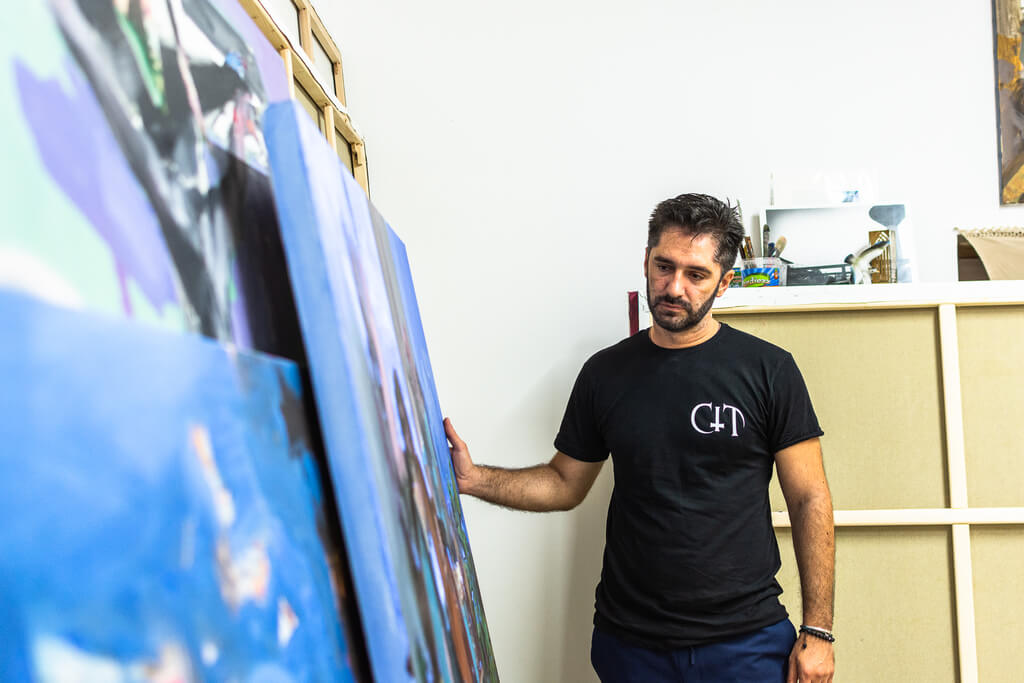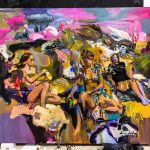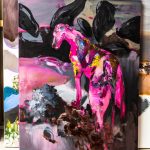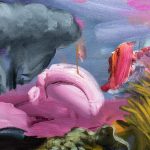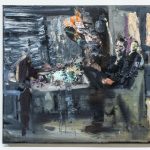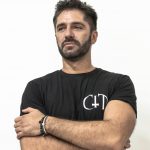On July 13, 2021, the opening of the exhibition of the artist Liviu Mihai, „Marilyn and the pink dog”, will take place at the Senso Gallery. We talked to Liviu Mihai to find out more about the works that the public will be able to see at the Senso Gallery until the end of August. We were impressed by the sensitivity and the depth of his approach and we are glad that we can share this interview with the visitors of the gallery site.
The Senso Gallery: What will be the title and theme of this summer’s exhibition at the Senso Gallery?
Liviu Mihai: The name of the exhibition is „Marilyn and the pink dog”. I approached a topic about Marilyn Monroe after reading something from her biography and I was impressed by certain things. I took this pop icon and I made an interpretation after a photo with it. The dog theme is an older theme of mine, which I have always approached. There will be two works with dogs in the exhibition. It’s about greyhounds. Actually I think as a child I was obsessed with dogs. When I was little I was crazy about animals, especially about dogs. I grew up in the country and my grandparents had many dogs. I always wanted a dog, but my mother didn’t agree because she didn’t want to have a dog in the apartment in a block. I loved dogs and I was set on this breed of dog somehow, which… so to speak… for me it is not really a dog. It’s a strange animal, with a strange physiognomy, that doesn’t actually bark. It is fierce but, at the same time, elegant as a dancer… Apparently there is no connection between these two entities, the dog and Marilyn… We have a slightly surreal, avant-garde connection and title. I found this connection. I liked it, it has something absurd. There are two seemingly very different things. I created a somewhat abstract connection between them.
S.G.: How will the chromatics of the works be?
L.M.: The chromatics of the works already exist. Because the works exist and the chromatics will be given by the works that will be exhibited. It is not just one project in the exhibition, in the sense that it is not a project made especially to be exhibited. I will present works from the last three years. So I will have works from several directions that I study and approach. I mean, I have topics that are related to the political area, topics that are related to man in general, to the social man, maybe topics related a little to religion, I also addressed topics related to the World Wars. Some works are even very fresh. I made them when I was for the last time in Greece. I stayed there for two months. I did a personal residency in Greece and I created a few smaller works. They are works inspired by that environment, in general, but mixed with symbols and characters or subjects that I already had in my imagination, with which I keep working, in fact.
S.G.: Will there be a connection between some works and what has happened in the world in the last year and a half (the pandemic that has not ended) or have you tried to avoid this topic?
L.M.: I created a work on this topic last year, when paranoia was at its peak. At one point I saw an image on the Internet, which somehow moved me, with some doctors hugging, at a time that was probably overwhelming for them. I had an interpretation on this topic, after which I didn’t really like it. I exhibited the work online. People really appreciated it. After that, after a short period of time, I did not like the subject and the theme, although I liked the work from a plastic, aesthetic point of view. But I thought it was a work from a moment of sensitivity. Maybe it was a little too dramatic … I felt it was a little forced. I thought maybe it was too situational. So I gave up that work and just made another work over it. So the work is gone!
S.G.: That’s very interesting! Somehow it’s still there, it’s just hidden. Maybe in a hundred years it will be seen under a microscope as it is cleaned…
L.M.: Exactly as it happens with the great masters. Yes, the work exists. It’s true what you say. I gave it up because the idea is that it wasn’t a topic I could continue and I said it didn’t make sense… I said that maybe it’s better to forget about it… although you can’t forget about the pandemic, about this moment… but I didn’t see it as something conclusive between my creations.
S.G.: I know you are fascinated by human nature and its “hidden” side. Will the theme of the exhibition be related to this preoccupation of yours? In a way, you’ve already told me about some kind of hiding.
L.M.: There was even a physical hiding. In most of my works, man is the main subject. Man in many hypostases, social, political, psychological. I speculate on man in all directions. Among the works that I will exhibit will be a work or two on the topic of the family. It’s a topic I’ve been working on several times lately, actually. I am inspired by a new family. My sister has a three-year-old child and I also made a video on this topic. At one point I really wanted to do a small project on the idea of family and family man, as I see it now. I don’t mean the family in general, but rather it would be an introspection on the family, which would mean some relatives of mine, in fact, relatives… my sister, my brother-in-law and their son.
S.G.: So you’re the cool uncle now!
L.M.: Yes, I’m the artist uncle. But the nephew is a bit small, only from now on he begins to be aware of what is happening around him.
S.G.: Will you also exhibit works with historical themes (another field that concerns you)?
L.M.: At one point I made a series of portraits, after a documentary that I saw and that really impressed me. It was a documentary made by Peter Jackson, who worked on Lord of the Rings. It’s called They Shall not Grow Old. It is made of very old films, recovered from that period, from a hundred years ago, in collaboration with the History Museum in London. The films were black and white and they took them over and, with the help of new technology, they turned them into films with a much higher resolution. They also colored them. The result was that they simply looked like images from a movie made today. It looked like a historical film being shot now. I don’t know how they did that, but you see people’s expressions much more clearly, you see the details. Everything is much clearer. They added sounds, they added everything. Actually the movies were silent. They added sound, edited everything and recreated the entire atmosphere. That is, they used the movie technology, with sounds for footsteps, for weapons, for cannons, for rain, for distant, close noises… they were all added. All this simply gives more vitality. It’s more realistic that way. It’s about the WWI, which was much bloodier, in fact, than WWII. At least the mutilations were much more serious. That is, after WWII, the technology of plastic surgery began to develop. Because a lot of soldiers were mutilated. I did some research on the Internet and I was inspired by some photos with the mutilated soldiers who simply looked like monsters and I made some works on this topic. There were people who could no longer integrate into society. Artists… sculptors who created faces from certain materials were also involved in this technology. They were remodelling their noses or cheekbones, parts that were simply physically missing. I mean, you can get inspiration from anywhere. That’s how it works for me. I sit in front of the TV, I see something and maybe an idea can come to me instantly and from there I can build something else, in the same direction or in another direction that I am interested in.
S.G.: What audience are you addressing and what reactions do you expect from visitors?
L.M.: I wouldn’t say that I necessarily address a certain age group. I don’t think we can talk about ages. You probably need a little maturity to approach art in general. If you don’t want it to sound like a game. Children also have a perception of art, even at the Louvre. But children and adults have different perceptions. I understand the message differently and probably certain topics are interesting for a certain audience. Other topics have a different audience. I have never thought of targeting an age group. Messages and topics are for the general public. I’m not that niche. In the end, it’s up to the viewer or the audience. I have no expectations, in the sense that I do not want people to perceive a certain thing. I did not establish in advance a perception that I would like the public to have about something. That is the beauty of art after all, that the artist has a statement. The artist comes with his work and maybe the audience becomes a co-creator of that work. For example, if the work is not very figurative and not explicit enough, because they are often between abstract and figurative, people begin to project their own ideas and images over them, which they may already have in mind and make their own projections there and they tell me things that I didn’t actually put there. I did not put them there, but they put them, having their own projection, over that message, over that work. Maybe I wouldn’t like it any other way. In fact, I’m not that straightforward. I often let certain things be interpretable. I let the viewer have an input on things and create their own connections and projections. That doesn’t come out all the time… Maybe it’s because of the work style… After all, art clearly contains the idea of challenge.
